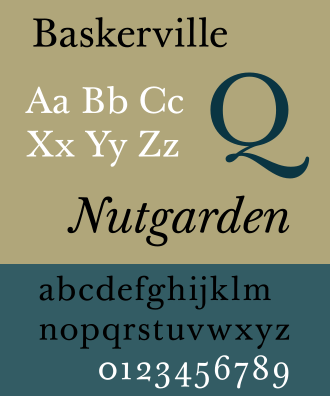John Baskerville facts for kids
Quick facts for kids
John Baskerville
|
|
|---|---|

Baskerville in later life, oil on canvas by James Millar.
|
|
| Born | 28 January 1707 (baptised) Wolverley, England
|
| Died | 8 January 1775 (age 68) Easy Hill, Birmingham, England
|
| Monuments | Industry and Genius |
| Occupation | Manufacturer, printer and type designer |
John Baskerville (born 1707 – died 1775) was an English businessman. He worked in many areas, including making shiny lacquered goods (called japanning) and items from papier-mâché (a material made from paper pulp). However, he is best known as a printer and someone who designed new typefaces (the styles of letters used in printing). He also invented "wove paper," which was much smoother than older paper, allowing for clearer and sharper printing.
Contents
John Baskerville's Life
John Baskerville was born in a village called Wolverley, near Kidderminster in England. He was baptised on January 28, 1707.
Early in his career, Baskerville taught handwriting. He also carved gravestones. Later, he made a lot of money from making lacquerware, which are decorative items with a hard, shiny finish.
He became a printer in Birmingham, England. Baskerville was part of the Royal Society of Arts, a group that promoted arts and manufacturing. He was also connected to some members of the Lunar Society, a famous club for important thinkers and scientists.
Baskerville guided his punchcutter (someone who carves the metal shapes for letters), John Handy, to create many typefaces that looked similar. His typefaces were greatly admired by Benjamin Franklin, who was also a printer. However, other printers who were jealous criticized Baskerville's work, and his typefaces soon became less popular.
Baskerville also started a completely new way of arranging text on a page. He used wide margins (empty space around the edges) and more leading (space between lines of text). This made books easier to read.
In 1757, Baskerville printed a special edition of a book by the Roman poet Virgil. He used his own typefaces and his new "wove paper." It took three years to finish, but it was so impressive that he was chosen to be the official printer for the University of Cambridge the next year. Even though he had his own personal beliefs, he printed The Book of Common Prayer in 1762 and a beautiful large Bible in 1763.
Baskerville was very creative in how he produced books. He worked with a paper maker named James Whatman to create a smoother, whiter paper. This paper, often called "wove paper," really showed off his bold, dark typefaces.
His Death and Burials
Baskerville passed away in January 1775 at his home, Easy Hill. He had a special wish for his burial. He wanted his body to be placed in a unique, cone-shaped building on his own property. He had prepared a vault there for it. He felt this was a personal choice, as he didn't believe in traditional burial grounds.
However, things didn't go as he planned. In 1821, a canal was built through his land. His body was then put on display by the landowner. Eventually, Baskerville's family and friends arranged for his remains to be moved to the crypt (an underground room) of Christ Church, Birmingham.
Later, in 1897, Christ Church was torn down. So, his remains, along with others from the crypt, were moved again to consecrated catacombs (underground burial tunnels) at Warstone Lane Cemetery. In 1963, people asked the Birmingham City Council to rebury him in unconsecrated ground, which was what he had originally wanted.
Baskerville's Legacy
In the 20th century, people became interested in and appreciated Baskerville's typefaces again. His most famous typeface, called Baskerville, is seen as a top example of a "transitional" typeface. This means it bridges the gap between older and more modern type designs.
Since the 1920s, many fonts based on his work have been created by different companies. Most of these new fonts are also called 'Baskerville'. In 1996, a company called Emigre released a popular new version of his typeface called Mrs Eaves. This font was named after Baskerville's wife, Sarah Eaves.
How He Is Remembered
In the 1930s, a building called Baskerville House was built on the land where his home, Easy Hill, once stood.
In 1947, the BBC radio aired a play about his burial. The original recording is lost, but students performed it again in 2013.

A sculpture made of stone, called Industry and Genius, stands in front of Baskerville House in Centenary Square, Birmingham. It honors Baskerville and his typeface. A local artist named David Patten created it in 1990.
Gallery
Here are some examples of books printed by John Baskerville.
-
Title-page of the 1757 quarto edition of the works of Virgil
-
John Milton's Paradise Lost (1758)
-
Volume One of The works of Joseph Addison (1761)
-
The 1766 translation of Virgil into English, by Robert Andrews
See also
 In Spanish: John Baskerville para niños
In Spanish: John Baskerville para niños
- William Caslon, another famous type-founder and printer from his time







